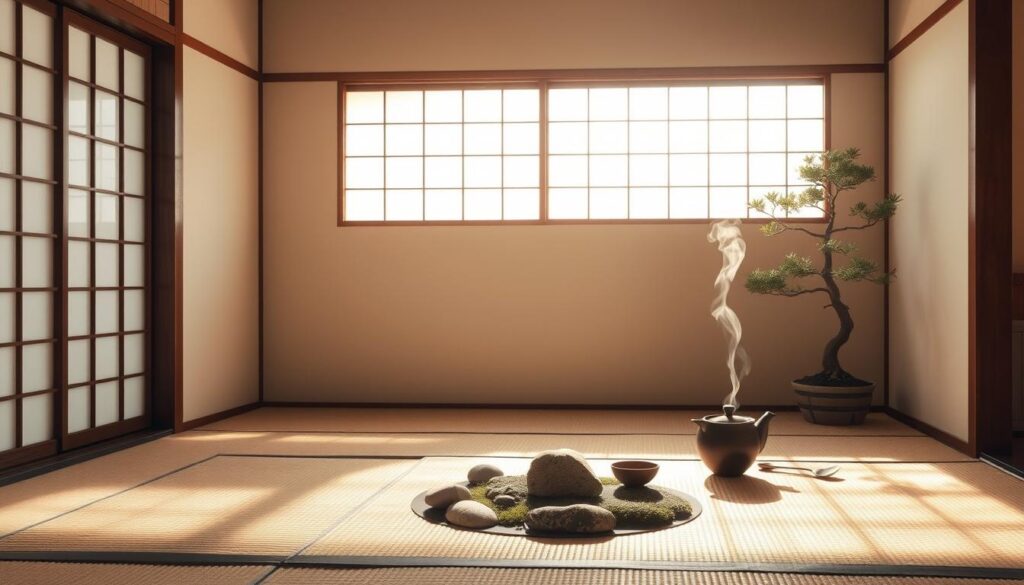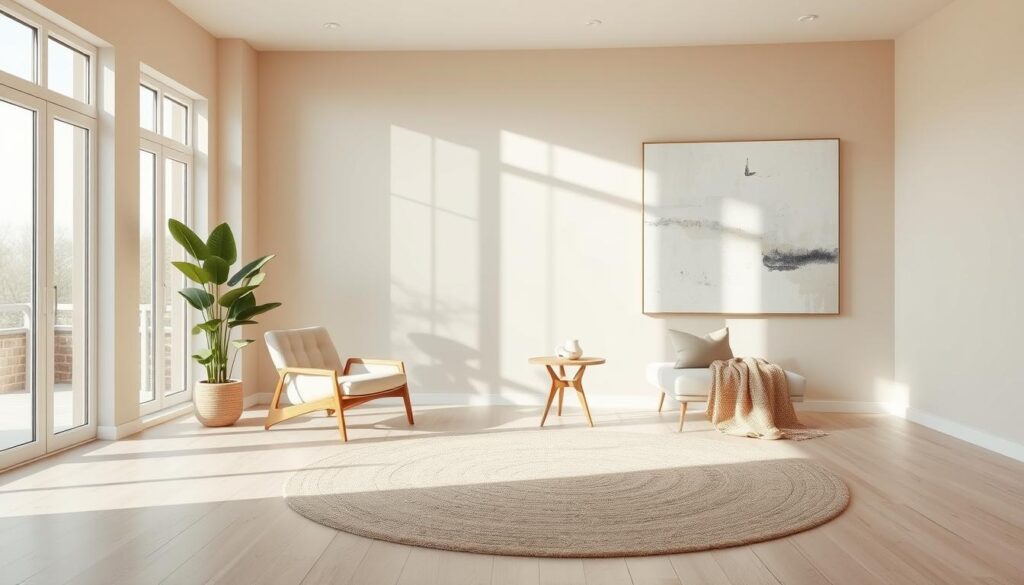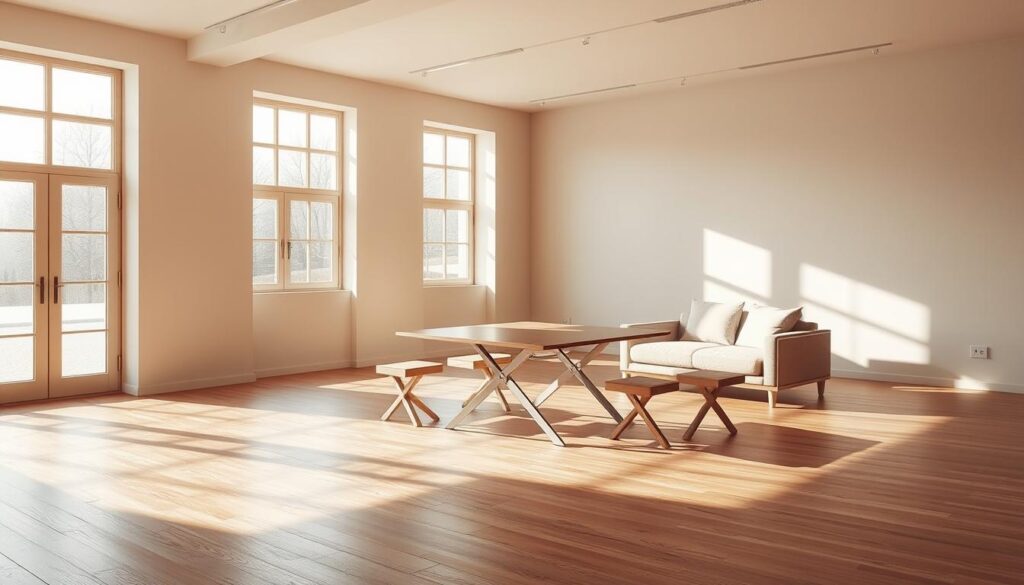Minimalism in interior design is very appealing. It turns an empty room into a peaceful place. This idea is not just about having more space. It’s about making a room a calm, Zen-like area.
Today, we all want a quiet, clean space. Minimalism helps us achieve this. It makes our homes feel fresh and calm. Imagine a room where everything is chosen carefully, making you feel clear and focused.
Minimalism is all about simplicity and choosing what’s important. An empty room is a chance to create something special. It’s a place where beauty and usefulness come together. With the right design, your empty room can become a peaceful Zen space.

The Philosophy of Emptiness
The philosophy of emptiness is close to minimalism. It says owning less leads to a more meaningful life. It teaches people to clear out their spaces. This makes their homes more organized and improves their mental health.
Understanding Minimalism
Minimalism is about focusing on what’s important. It means getting rid of things we don’t need. This way, we can live simply in all parts of our lives.
This idea is linked to the Zen lifestyle. It’s about being mindful and finding balance. We end up with a calm, tidy home that brings us peace.
The Psychological Benefits of Space
Having a clean space can really help our minds. Getting rid of too much stuff makes our homes look better. It also makes us feel better mentally.
A clutter-free home reduces stress and helps us focus. It creates a calm place for our minds to rest. Living simply is a step towards a peaceful life, where every item has a purpose.
Transforming a Vacant Space
Turning an empty room into something special starts with a clear idea. You might want a cozy spot to read or a place to work from home. Knowing the room’s size and how much light it gets is key.
This helps you plan how to make the room look good and work well. It’s all about finding the right mix of looks and use.
Then, think about how different parts will fit together. A simple sketch of the room can help. It shows where to put furniture and decorations for the best look and use.
Think about how people will move around in the room. Good planning means furniture is placed for easy movement. For example, a desk near a window uses natural light, making a great workspace.
Lastly, think about what the room could be used for. A room can have more than one purpose. It could be a quiet spot for yoga in the morning and a fun area for hobbies at night. This way, you make the most of the space and create a lively, useful area in your home.
Creating a Meditative Sanctuary
In today’s noisy world, finding quiet in our homes is key. It helps us create a meditative space for relaxation and reflection. A space designed with mindfulness can turn an empty room into a peaceful Zen sanctuary.
The Importance of Quietude
Quietude is more than just no sound. It’s vital for a meditative sanctuary. It lets us step away from the chaotic world and connect with ourselves.
Choosing a room away from busy areas and soundproofing it helps a lot. Adding soft textures, gentle lights, and natural decor brings peace and calm.
Designing a Space for Mindfulness
Designing for mindfulness means simplicity and harmony. Pick furniture and decor that are simple yet meaningful. This helps keep the calm feeling.
Natural colors and elements like bamboo, stones, and plants add to the Zen feel. Adding personal touches, like meaningful art or meditation tools, makes the space special. A well-designed meditative space supports clear thinking and emotional health.
Design Tips for Empty Rooms
Turning an empty room into a cozy spot needs careful planning and creativity. Focus on design tips to change the room’s feel and use. Choosing the right colors and using natural light are key.

Choosing the Right Color Palette
Color psychology is key in setting a room’s mood. Knowing how colors affect us helps pick the right palette. Soft colors like light blues and pastels calm a room, perfect for relaxing areas.
Bright colors like yellows and oranges energize a space. They’re great for areas where you want to be active or creative.
Maximizing Natural Light
Natural light boosts a room’s look and feel. Big windows, skylights, and mirrors let in more daylight. This makes the room bright and welcoming.
Think about where the sun comes in and use curtains or blinds to control it. Using materials that let light through adds warmth and coziness.
Using these design tips can make any empty room beautiful and functional. It’s all about the colors and light you choose.
Multipurpose Uses for Empty Spaces
Turning an empty room into something useful can make your home better. You can have a productive home office or a fun hobby room. These ideas help you use space in many ways.
From Empty Room to Home Office
Turning an unused room into a home office is smart. Choose furniture that’s good for long work hours. Add shelves and organizers to keep things neat.
Make the space your own with decor that inspires you. This will help you stay motivated and creative.
Revamping a Room for Hobbies
Want a space for hobbies? Turn the room into a hobby room. Use modular storage for different activities, like crafting or music.
Make sure the room is comfy and well-lit. A good hobby room is inspiring and fun for relaxation and creativity.
Personal Stories: Embracing the Empty Room
Empty spaces have a special power. They help us grow and find ourselves. In a world full of distractions, some find peace in minimalism. It unlocks their true potential.
A Journey of Self-Discovery
Jane found a new start in an empty room. At first, it felt too quiet. But it became a place for deep thoughts and creativity.
She learned that an empty room is like a blank canvas. It helps us discover and grow in ways we never thought possible.
Finding Inspiration in Emptiness
Chris made a meditation spot in his home. It was simple, but it helped him focus. He found peace and creativity in this quiet space.
This experience showed him the power of inspirational spaces. They are good for our minds and hearts.
Decorating with Intentionality
Adding mindful decorating to your home doesn’t mean losing your style. It’s about adding meaningful things that make your space better. This careful choice, known as intentional interiors, makes your room open yet full of character.
First, think about what the room is for. Is it for relaxing or working? Purposeful design means every piece has a role. Pick items that are both beautiful and useful, like a stylish storage ottoman or a bookshelf that also divides the room.
Then, think about how each item makes you feel. Intentional interiors should bring out certain emotions or memories. Choose pieces that mean something to you. This way, your home becomes a place that shows who you are.
Finally, decorating with purpose means keeping things simple and meaningful. By doing this, you create a space that looks great and feels personal and useful.
The Role of Furniture in Empty Spaces
Furnishing an empty room is a big challenge. It needs a careful eye for furniture selection that fits the space well. The right choices can turn a blank room into a peaceful, balanced place.

Selecting Versatile Pieces
Choosing versatile furnishings is key. It makes the room flexible and useful without making it too full. Items like modular sofas, extendable tables, and multi-use storage fit many needs. This keeps the room open and tidy.
Maintaining Balance with Furniture
Getting space balance right is important in furniture design. Placing big items carefully helps the room feel natural and not too tight. Think about the size and scale of each piece. This makes sure it adds to the room’s beauty, not mess it up.
Small things can also help make the room welcoming and balanced. They add to the bigger furniture, making the space feel cozy and complete.
Turning Emptiness into Opportunity
Seeing an empty room as a chance to start fresh can open up new possibilities. Instead of seeing it as empty, think of it as a blank canvas. This allows you to create a space that truly reflects your style and needs.
Start by imagining all the ways you could use the room. Maybe you want a cozy reading spot, a productive office, or a place to make art. An empty room can become anything you dream of.
The best part of an empty room is its flexibility. You can try out different layouts and colors until you find what works best for you. This way, your space can grow and change with you.
Changing how you see an empty room is key. See it as a chance to be creative and make it your own. This way, you turn a blank space into a place full of possibilities, just waiting for your touch.
Mindful Living: Less is More
In today’s fast world, mindful living is a fresh way to improve our well-being. It helps us create peaceful spaces by embracing minimalism.
How Minimalism Enhances Your Life
Minimalism is more than a clean home. It makes us focus on what’s important. This lifestyle reduces stress and boosts happiness.
It also makes sure our homes support our mental health. Living mindfully connects us to our surroundings and makes life better.
Steps to Declutter Your Home
Decluttering might seem hard, but it’s doable. Start by sorting items into three piles: keep, donate, and discard. Begin with one area to stay focused.
Being consistent and patient is key. Enjoy the simplicity and how it improves your life.
Embracing the Empty Room in Modern Living
In today’s cities, living in small spaces is common. Empty rooms can change how we live, making our homes simple and useful. The idea of small space living means using every bit of space well, mixing usefulness with beauty.
Adapting to Smaller Living Spaces
Living in small spaces needs creativity and smart thinking. By using urban minimalist design, people create spaces that feel big and open. It’s important to pick furniture that can be used in many ways and to find clever storage spots.
The Urban Lifestyle and Empty Rooms
City living means using space wisely, and empty rooms are key. These rooms can be many things, like a place to work, practice yoga, or relax. Using urban minimalist design keeps spaces clean and helps us stay focused and calm.
Case Studies: Real-Life Transformations
Exploring room transformation stories shows the power of interior design. From dull rooms to lively spaces, these stories are full of creativity. They offer great ideas for changing your home.
A studio apartment was turned into a modern home. It used a single color and lots of light. Now, it’s calm and stylish. This shows how design can change a room a lot.
An attic was made into a cozy reading spot. It got bookshelves and soft lights. Now, it’s a favorite place. These stories show how creativity can change any space.
A cluttered basement became a bright office. It was cleaned up and got useful furniture. Now, it’s a place to work and relax. These examples show how design can make a big difference.
These stories show the amazing changes possible in homes. They also show the value of careful design. By looking at these examples, you can get ideas for your own space.
The Future of Home Design
Looking ahead, minimalist design is becoming more popular. It focuses on simplicity and function. This makes homes both beautiful and efficient.
The Trend Towards Minimalism
Minimalist design is more than looks. It’s a way of life. It means having only what you need, for a calm space.
With smaller homes, minimalism helps use space well. It brings peace to our living areas.
Incorporating Sustainability
Sustainable living is key in future home trends. People want homes that are good for the planet.
They look for green materials and energy-saving gadgets. This makes homes stylish and eco-friendly.
Crafting a Space for Creativity
Creating a room for creativity needs balance. It’s about mixing inspiration with simplicity. Whether it’s for an artist, writer, or crafter, the goal is to make a space that boosts creativity. This space should follow the rules of minimalism, removing distractions to let ideas grow.
Think about the basics: lighting, color, and furniture. Natural light is key for artists. A big window and easel combo can light up your canvas perfectly. For writers, soft colors help focus. And, furniture that fits well keeps the room tidy.
Adding personal touches is important. Hang art, quotes, or vision boards that inspire you. But, remember, simplicity is key. A clean space means a space that’s thoughtfully designed for creativity. So, your room should show your style and creative path.